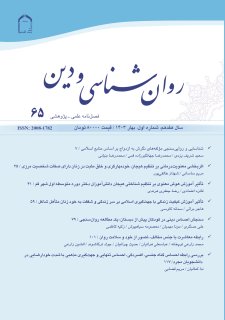صفحهها:
101-116
تاریخ دریافت: 1401/11/22
تاریخ پذیرش: 1402/03/03
چکیده:
این پژوهش با هدف بررسی رابطه بین متغیرهای معاشرت با جنس مخالف، تصور از خود و سلامت روان انجام شده است. پژوهش کمی و از نوع همبستگی است. حجم نمونه پژوهش 385 تن از دانشآموزان دبیرستانهای دخترانه شهرستان رباط کریم است که با استفاده از روش «نمونهگیری خوشهای تصادفی» انتخاب شدند. ابزار استفاده شده در این پژوهش، پرسشنامه 9 سؤالی «معاشرت با جنس مخالف»، پرسشنامه 25 سؤالی «تصور از خود» و پرسشنامه 28 سؤالی «سلامت عمومی» است. دادهها بر اساس ضریب همبستگی پیرسون و رگرسیون دومتغیره همزمان تحلیل شد. یافتهها حکایت از آن دارد که بین سه متغیر «معاشرت با جنس مخالف«، «تصور از خود» و «سلامت روان» رابطه معناداری وجود دارد. افزایش خودمهارگری در معاشرت با جنس مخالف با بهبود تصور از خود و افزایش سلامت روان همبسته است. یافته دیگر اینکه خودمهارگری در معاشرت با جنس مخالف و تصور از خود میتوانند قریب 16 درصد از واریانس سلامت روان را تبیین نمایند. بنابراین، معاشرت با جنس مخالف، سلامت روان و تصور از خود را کاهش میدهد.
Article data in English (انگلیسی)
Title:
The Relationship between Having Relation with the Opposite Sex, Self-Concept and Mental Health
Abstract:
This research is conducted to study the relationship between the three variables of having relationship with the opposite sex, self-concept and mental health. The research is quantitative and correlational. The sample size of the research is 385 students of girls' high schools in Robat Karim city, who were selected using the "random cluster sampling" method. The following tools are used in this research: the 9-question "Association with the opposite sex" questionnaire, the 25-question "Self-concept" questionnaire and the 28-question "General Health" questionnaire. The collected data is analyzed based on Pearson's correlation coefficient and simultaneous bivariate regression. According to the findings of this research, there is a meaningful relationship between the three variables of "having relationship with the opposite sex", "self-concept" and "mental health". There is a relationship between ‘increase of self-control in the relation with the opposite sex’ and ‘improvement of self-concept’ and ‘mental health’. According to another outcome, self-control in the relations with the opposite sex and self-image can explain nearly 16% of the variance of mental health. Therefore, having relation with the opposite sex reduces mental health and self-concept.
References:
- آزاد ارمکی، تقی و محمدحسین شریفی ساعی، 1390، «تبیین جامعهشناختی روابط جنسی آنومیک در ایران»، خانوادهپژوهی، ش 28، ص 435-492.
- ادهمی، محمد کمالالدین، 2004، مرآة النساء فیما حسن منها و ساء، دمشق، دارالتوفیق.
- بهمنی، بهمن و علی عسکری، 1385، «هنجاریابی ملی و ارزیابی شاخصهای روانشناسی پرسشنامه سلامت عمومی برای دانشجویان علوم پزشکی ایران»، در: مجموعه مقالات سومین سمینار سراسری بهداشت روانی دانشجویان ایران.
- بیابانگرد، اسماعیل، 1384، روشهای تحقیق در روانشناسی و علوم تربیتی، تهران، دوران.
- تمیمی آمدی، عبدالحمیدبن محمد، 1366، غررالحکم و دررالکلم، قم، دفتر تبلیغات اسلامی.
- حرعاملی، محمدبن حسن، 1409ق، وسائلالشیعه، قم، آلالبیت.
- خوانساری، میناسادات و علی سلیمانی، 1390، «مقایسه هوش هیجانی دو گروه مجرد دارای ارتباط و بدون ارتباط با جنس مخالف در شهر تهران»، اسلام و پژوهشهای تربیتی، ش 2، ص 145-159.
- رجبلو، علی و سارا اصغری، 1389، «جهانیشدن و بازاندیشی الگوهای دوستی دختران و پسران: مطالعه موردی دانشجویان دانشگاه تهران»، مطالعات اجتماعی روانشناختی زنان، سال هشتم، ش 2، ص 73-92.
- رفاهی، ژاله و همکاران، 1391، «بررسی عوامل مؤثر بر شکلگیری رابطه دوستی پیش از ازدواج بین دختران و پسران از دیدگاه دانشجویان»، جامعهشناسی زنان، ش 1، ص 117-133.
- زارعی توپخانه، محمد، 1390، «روابط آزاد زن و مرد از دیدگاه آموزههای دینی و روانشناسی»، معرفت، ش 163، ص 81-96.
- شعاعکاظمی، مهرانگیز، 1387، «بررسی مقایسهای رفتار چت کردن و رابطه آن با خودپنداره دانشجویان دانشگاه الزهراء»، مطالعات روانشناختی، ش 15، ص 27- 38.
- فتحیآشتیانی، علی، 1388، آزمونهای روانشناختی، تهران، بعثت.
- کوثری، محمدرضا، 1373، بررسی علل رابطه با جنس مخالف در دانشآموزان دختر راهنمائی تحصیلی منطقه 18 آموزش و پرورش شهر تهران و ارائه راهحلهای مسئله در سال تحصیلی 73-72، پایاننامه کارشناسی ارشد، تهران، دانشگاه علامه طباطبائی.
- گلزاری، محمود، 1384، «آموزش و مشاوره با نوجوانان در زمینه ارتباط با جنس مخالف»، روانشناسی تربیتی، ش 1، ص 105-122.
- گنجی، حمزه، 1385، روانشناسی تجربی کاربردی، تهران، بعثت.
- ماهینی، انسیه و عزت دیره، 1391، «پژوهشی در ارتباط دختر و پسر و نقد دیدگاهها»، پژوهشنامه اخلاق، ش 16، ص 86-109.
- مجلسی، محمدباقر، 1404ق، بحارالانوار، بیروت، مؤسسة الوفاء.
- ملازمانی، علی و علی فتحی آشتیانی، 1387، «تأثیر آموزش به شیوه ایفای نقش بر بهبود تصور از خود نوجوانان»، علوم رفتاری، ش 1، ص 61-66.
- موسوی، سیدرضا، 1391، «عوامل و زمینههای گسترش روابط دختران و پسران با رویکرد به عوامل شخصیتی»، معرفت، ش 176، ص 85-98.
- نوری، میرزاحسین، 1408ق، مستدرک الوسائل، قم، مؤسسة آلبیت(ع).
- Albright J. M, 2008, "Sex in America online: an exploration of sex, marital status, and sexual identity in internet sex seeking and its impacts", Journal Sex Researh, No. 45, 2, p. 175-186.
- Aponte, M. R, & et al, 2012, "University students' social representations concerning sexual abstinence and the condom as prevention mechanisms", Revista de Salud Publica (Bogota), No. 14, p. 491-501.
- Beedy, M. D, & et al, 2008, "Understanding sexual abstinence in urban adolescent girls", Obstetric Gynecologic and Neonatal Nursing, No. 37, 18, p. 185-195.
- Bc, G. B, & Basel, P. L, 2013, "Premarital sex behaviors among college youths of Kathmandu", Kathmandu University medical gournal, No. 11, p. 27-31.
- Bogart, L. M, & et al, 2007, "Association of sexual abstinence in adolescence with mental health in adulthood", Sex Researh, No. 44, p. 290-298.
- Chapin, J. R, 2000, "Adolescent sex and Mass Media: A developmental Approach", Adolescence, No. 35(140), p. 799-811.
- Chiao, C, & et al, 2012, "Exploring the relationship between premarital sex and cigarette/alcohol use among college students in Taiwan: a cohort study", BMC.Public Health, No. 12, p. 1-10.
- Chiao, C. & Yi, C. C, 2011, "Adolescent premarital sex and health outcomes among Taiwanese youth: perception of best friends' sexual behavior and the contextual effect", AIDS Care, No. 23, p. 1083-1092.
- Colson, C, 2003, Twisting Reality: Teenagers, Sex and Depression, From http://townhall.com/columnists/chuckcolson/2003/06/17/twisting_reality_teenagers,_sex,_and_depression/page/full.
- Cunningham, M, & Thornton, A, 2006, "The influence of parents' marital quality on adult children's attitudes toward marriage and its alternatives: main and moderating effects", Demography, No. 43,p. 659-672.
- Crichton, J, & et al, 2012, "Mother-daughter communication about sexual maturation, abstinence and unintended pregnancy: experiences from an informal settlement in Nairobi", Kenya. Adolescence, No. 35, p. 21-30.
- Elhage, A, 2009, "Ten Reasons to Keep Abstinence Education in North Carolina", Family North Carolina Magazine, No. 4, p. 8-10.
- Gutierrez, F. L, & et al, 2010, "Determinants of sexual abstinence and condom use among Central American adolescents", Adolescent Medicine and Health, No. 22, p. 583-593.
- Kabiru, C. W, & Ezeh, A, 2007, "Factors associated with sexual abstinence among adolescents in four sub-Saharan African countries", Reproductive Health, No. 11, p. 111-132.
- Koffi, A. K, & Kawahara, K, 2008, "Sexual abstinence behavior among never-married youths in a generalized HIV epidemic country: evidence from the 2005 Cote d'Ivoire AIDS indicator survey", BMC Public Health, No. 8, p. 1-18.
- Kagimu, M, & et al, 2011, Religiosity for Promotion of Behaviors Likely to Reduce New HIV Infections in Uganda: A Study Among Muslim Youth in Wakiso District, Religion and Health, Epub ahead of print.
- Mir, A. M, & et al, 2013, "Exploring urban male non-marital sexual behaviours in Pakistan", Reproductive Health, No. 10(1), 22, Epub ahead of print.
- Oladepo, O, & Fayemi, M. M, 2011, "Perceptions about sexual abstinence and knowledge of HIV/AIDS prevention among in-school adolescents in a western Nigerian city", BMC Public Health, No. 11, p. 304-311.
- Orth, U, & et al, 2009, "Low self-esteem is a risk factor for depressive symptoms from young adulthood to old age", Journal of Abnormal Psychology, No. 118, p. 472–478.
- Ott, M. A., Pfeiffer, E. J., & Fortenberry, J. D, "2006, Perceptions of sexual abstinence among high-risk early and middle adolescents", Journal of Adolesc.Health, No. 39, p. 192-198.
- Perkins, D. F, & et al, 2002, "Protective Factors, Physical Abuse, and Purging From Community-Wide Surveys of Female Adolescents", Journal of Adolescent Research, No. 17 , p. 377-400.
- Pina, R A. R, & et al, 2005, "Depression in urban Hispanic adolescents", The International Journal of School Disaffection, No. 3, p. 8–14.
- Rector, E. R, & et al, 2003, Sexually Active teenagers are more likely to be depressed and to attempt suicide, Washington, The Heritage Foundation.
- Rector, E. R, & et al, 2005, Teenage Sexual Abstinence and Academic Achievemen, Washington, The Heritage Foundation.
- Regnerus, M. Uecker, J, 2011, Premarital Sex in America: How Young Americans Meet, Mate, and Think about Marrying, New York, Oxford University Press.
- Sahay, S, & et al, 2013, "Correlates of Sex Initiation among School Going Adolescents in Pune", India, No. 80 (10), p. 814-820.
- The Institute for Youth Development, 2010, Benefits of Delaying Sexual Debut Executive Summary, From http://www.youthdevelopment.org.
- Wang, R. H, & Hsu, H. Y, 2006, "Correlates of sexual abstinence among adolescent virgins dating steady boyfriends in Taiwan", Nursing Scholarship, No. 38, p. 286-291.
- Wang, R. H, & et al, 2009, "Predictors of sexual abstinence behaviour in Taiwanese adolescents: a longitudinal application of the transtheoretical model", Clinial Nursing, No. 18, p. 1010-1017.
- Wilson, K. L, & et al, 2005, "A review of 21 curricula for abstinence-only-until-marriage programs", School Health, No. 75, p. 90-98.
- Wright, P. J, & et al, 2013, United States Women and Pornography Through Four Decades: Exposure, Attitudes, Behaviors, Individual Differences, Sexual Behavior, Epub ahead of print.
شیوه ارجاع به این مقاله:
RIS
Mendeley
BibTeX
APA
MLA
HARVARD
VANCOUVER
APA | MLA | HARVARD | VANCOUVER
زارعی توپخانه، محمد، هراتیان، عباسعلی، چراغیان، حدیث، ترکاشوند، جواد، زارعی، افشین.(1403) رابطه معاشرت با جنس مخالف، تصور از خود و سلامت روان. فصلنامه روانشناسی و دین، 17(1)، 101-116 https://doi.org/10.22034/ravanshenasi.2024.2003488
APA | MLA | HARVARD | VANCOUVER
محمد زارعی توپخانه؛ عباسعلی هراتیان؛ حدیث چراغیان؛ جواد ترکاشوند؛ افشین زارعی."رابطه معاشرت با جنس مخالف، تصور از خود و سلامت روان". فصلنامه روانشناسی و دین، 17، 1، 1403، 101-116
APA | MLA | HARVARD | VANCOUVER
زارعی توپخانه، محمد، هراتیان، عباسعلی، چراغیان، حدیث، ترکاشوند، جواد، زارعی، افشین.(1403) 'رابطه معاشرت با جنس مخالف، تصور از خود و سلامت روان'، فصلنامه روانشناسی و دین، 17(1), pp. 101-116
APA | MLA | HARVARD | VANCOUVER
زارعی توپخانه، محمد، هراتیان، عباسعلی، چراغیان، حدیث، ترکاشوند، جواد، زارعی، افشین. رابطه معاشرت با جنس مخالف، تصور از خود و سلامت روان. روانشناسی و دین، 17, 1403؛ 17(1): 101-116







